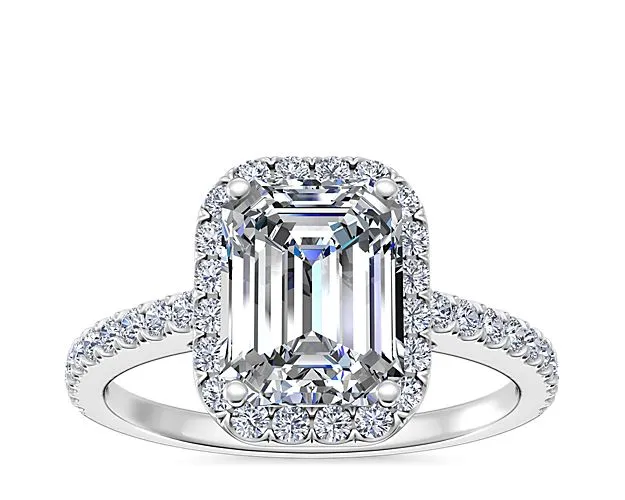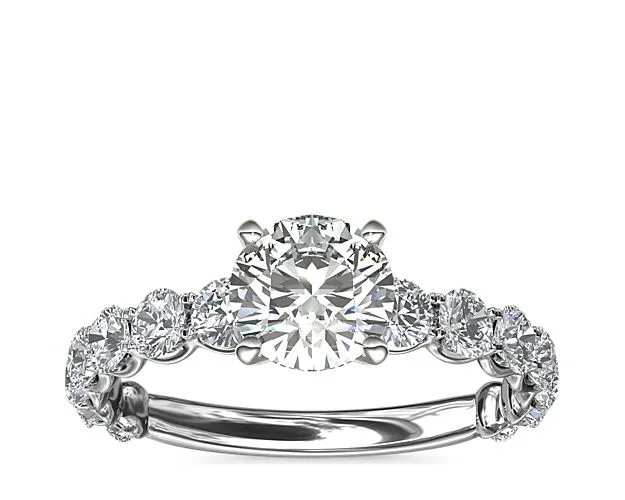Introduction
One of the biggest categories in the jewelry industry is “white metal”, which includes anything from the priciest and most costly metals, such as palladium, platinum, and white gold, to more cheap metals like silver and stainless steel.
White metals are essential to a jeweler’s success and may be utilized in a wide range of jewelry goods due to their diverse properties and pricing.
It gives the flexibility to accommodate any customer’s budget and chosen look, from engagements and weddings to everyday wear.
White gold and platinum may look similar, but they have unique properties. White gold is a yellow gold alloy that has been combined with white metals such as silver or palladium. To improve its whiteness, it is frequently coated with rhodium.
What is White Gold?
Jewelers create white gold, a preferred choice for fine jewelry, by mixing pure gold with white metals like nickel, silver, or palladium.
They enhance its elegant appearance with rhodium plating. Originally developed to imitate platinum, it typically contains 75% gold, 25% nickel, and 25% zinc.

White gold is durable and suitable for everyday wear, but its rhodium plating may wear off over time, revealing a slightly yellowish tint. It should be cleaned periodically to remove dust and oil.
A jeweler can buff it, but frequent polishing can accelerate the wearing down of the rhodium plating.
Pros
- It is less expensive than platinum.
- It is a beautiful-looking metal.
- There is a wider selection of rings available in white gold.
- It is made from metals that do not tarnish.
- It is scratch-resistant.
Cons
- It will turn yellow over time.
- It needs to be rhodium-plated periodically
White gold is budget-friendly, but prices can vary based on purity and gemstone quality. Work with a reputable jeweler and consider long-term rhodium re-plating costs when budgeting for white gold jewelry.
What is Platinum?
Platinum is a rare and exceptional precious metal, part of the platinum group of metals. It is dense, heavy, and naturally white, making it ideal for crafting fine jewelry due to its durability and resistance to tarnish.
Platinum jewelry is marked with the hallmark “Pt,” indicating its purity. It is often alloyed with other platinum-group metals such as palladium, iridium, and ruthenium. The purity is indicated by a three-digit number, such as 950 PT.

It is a durable, high-density metal ideal for everyday wear, especially in engagement and wedding bands. It’s hypoallergenic, doesn’t tarnish, and requires minimal maintenance.
To clean it, soak it in warm water and scrub gently. Professionally trained jewelers periodically inspect platinum jewelry for loose stones or potential issues.
Pros
- It is more durable than other metals and offers protection from everyday wear and tear.
- It is only a true hypoallergenic metal because it’s 95% pure.
- It is highly reflective and doesn’t require rhodium plating to maintain its whiteness.
- It has a patina finish that some people find beautiful.
Cons
- It is more expensive and requires more skill to produce.
- Rings that scratch or bend easily are most likely made of 950 platinum-iridium.
Platinum is a highly expensive metal in jewelry due to its rarity and exceptional qualities. Its price varies depending on purity, market variables like supply and demand, craftsmanship and designs, brand reputation, and location.
Custom platinum jewelry may be more expensive due to the specific design and expertise required. The price of platinum jewelry may also be affected by the complexity of the design, the quantity and quality of gemstones used, and the reputation of the brand or jeweler.
White Gold vs. Platinum: A side-by-side comparison
Here are some comparisons
| Properties | White Gold | Platinum |
| Strength and Hardness | White gold is less durable but may be more prone to scratches and dings over time. | Platinum is strong, durable, and ideal for intricate jewelry designs |
| Resistance to wear and tear | White gold requires rhodium re-plating for a silvery-white appearance | Platinum is resistant to tarnish, corrosion, and wear |
| Appearance and luster | White gold boasts a bright, shiny appearance with rhodium plating | Platinum offers an elegant, timeless appearance with a subtle matte finish |
| Price and cost differences | White gold is budget-friendly and popular for quality at a lower price point. | Platinum is expensive due to its rarity, purity, and premium qualities |
| Environmental and ethical considerations | White gold’s environmental impacts depend on its sourcing and mining industry practices | Platinum is eco-friendly due to its industrial applications and ethical sourcing practices |
How to Differentiate Between White Gold and Platinum
Markings and stamps
White gold and platinum jewelry often have specific markings to indicate their composition and purity. White gold jewelry is typically stamped with a karat mark, while platinum jewelry is stamped with a “Pt” or “PLAT” mark and sometimes a purity percentage.
Visual and weight differences
Platinum has a natural silvery-white color, while white gold has a slightly yellowish tone. Rhodium plating is used to maintain a silvery appearance but may wear off over time. Platinum is denser and heavier.
Tips for identifying the metals
To identify a metal in jewelry, check for markings, observe the color, compare the weight to known white gold and platinum, and consult a professional if uncertain. If lost rhodium plating, a yellowish tint of white gold may be visible.
Which Metal is Right for You?
Factors to consider when choosing between white gold and platinum
Personal preferences and lifestyle
Choose platinum or white gold jewelry based on color and shine, as platinum has a natural silvery-white appearance, while white gold has a brighter shine.
Budget and cost
Platinum is more expensive than white gold due to its rarity and quality, and its maintenance costs, including periodic rhodium replacement, can add to its long-term cost.
Durability and wear
Platinum jewelry is durable and hypoallergenic, making it suitable for those with active lifestyles and sensitive skin, making it a safer choice for daily wear.
Ethical and environmental considerations
Ethical sourcing and environmental impact are crucial when selecting metals for jewelry, as some metals may come from recycled sources and white gold’s impact may vary.
Gemstone compatibility
Consider the type and color of gemstones for your jewelry, as some pair better with natural platinum, while others shine better with bright white gold.
Long-term perspective
The long-term transformation of the metal can influence the choice between platinum’s natural patina or white gold’s constant shine.
Conclusion
White gold is an alloy of gold mixed with white metals, often plated with rhodium, while platinum is a naturally white metal without plating.
Platinum is more durable, resistant to wear and tear, and has a natural silvery-white color.
It requires minimal maintenance, is more expensive due to its rarity, and is heavier and denser.
When choosing between white gold and platinum for fine jewelry, consider your styles, lifestyles, budget, ethical and environmental concerns, gemstones, compatibility, and long-term perspective.
Consider your personal style, lifestyle, and budget when making your choice.
FAQ’S
White gold is a colored version of gold, meaning it is a different color from the original material.
Platinum is more malleable than white gold. This means it’s more difficult to bend out of shape, making it ideal for setting diamonds.
Platinum is a strong, durable metal that is less easily damaged by water.
Part of caring for a white gold engagement ring is having it replated, or dipped, every six months to one year.
Read more…..
